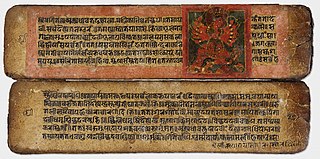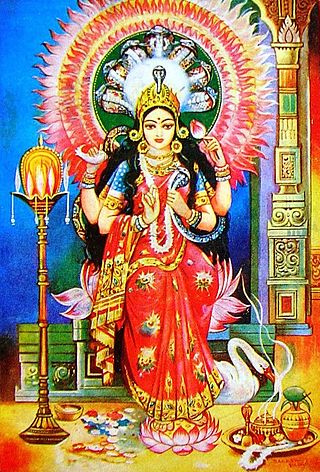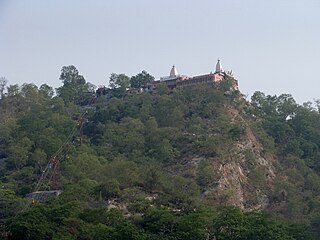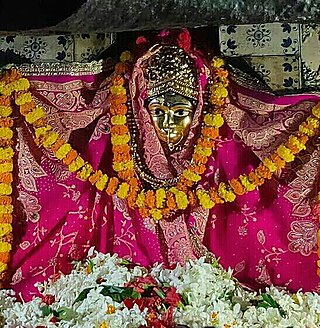
The Devi Mahatmya or Devi Mahatmyam is a Hindu philosophical text describing the Goddess, known as Mahadevi or Adishakti, as the supreme power and creator of the universe. It is part of the Markandeya Purana.

The Shakta pithas, Shakti pithas or Sati pithas are significant shrines and pilgrimage destinations in Shaktism, the mother goddess denomination in Hinduism. The shrines are dedicated to various forms of Adi Shakti. Various Puranas such as Srimad Devi Bhagavatam state the existence of a varying number of 51, 52, 64 and 108 Shakta pithas of which 18 are named as Astadasha Maha (major) in medieval Hindu texts.

Chandi or Chandika is a Hindu deity. Chandika is another form of Mahadevi. She shares similarities with the Goddess Chamunda, not only in name but also in attributes and iconography. Due to these similarities, some consider them to be the same deity, while others view them as different manifestations of Mahadevi. Both are often associated with other powerful goddesses like Durga, Katyayani, Kali and Kalaratri. The Goddess is particularly revered in Gujarat.

The Markandeya Purana is a Sanskrit text of Hinduism, and one of the eighteen major Puranas. The text's title Markandeya refers to a sage in Sanatana Dharma, who is the central character in two legends, one linked to Shiva and other to Vishnu. The Markandeya text is one of the Puranas that lacks a sectarian presentation of ideas in favor of any particular god, and it is rare to read any deity being invoked or deity prayers in the entire text.

Chandimandir Cantonment is a military cantonment of the Indian Army located in Panchkula district at the foot of the Sivalik Hills adjoining Panchkula city in Haryana. It is the headquarters of the Western Command of the Indian Army.
Chandur is a census town and Municipality and it is a Mandal Headquarters of Chandur Mandal in Nalgonda district & in the state of Telangana, India. It is located in Chandur mandal of Nalgonda division Postal code or Pin code: 508255. A beautiful and peaceful town. There are various legends about the etymology of the name one of the folklore says Chandi uuru as there is a famous Chandi maata temple of which the deity resembles to the goddess Durga of Vijayawada and is said to be commenced at the same time of the famous temple.

Chandi Prasad Bhatt is an Indian environmentalist and social activist, who founded Dasholi Gram Swarajya Sangh (DGSS) in Gopeshwar in 1964, which later became a mother-organization to the Chipko Movement, in which he was one of the pioneers. For his work Bhatt was awarded the Ramon Magsaysay Award in 1982, followed by the Padma Bhushan in 2005.

Chandi Mandir is a Hindu temple dedicated to Chandi the goddess of power, near Chandigarh, located on NH-5 Chandigarh-Kalka highway in Panchkula city of Haryana state of India. It is about 15 km from the city of Chandigarh, which was named after the temple, and about 10 km away from the Mansa Devi Shrine. The temple is situated amidst beautiful surroundings and the backdrop of the Shivalik hills.

Manasa is a Hindu goddess of snakes. She is worshipped mainly in Bihar, Odisha, Bengal, Jharkhand, South Assam and other parts of northeastern India and in Uttarakhand, chiefly for the prevention and cure of snakebite, and also for fertility and prosperity. In Hinduism, Manasa is the sister of Shesha and Vasuki, king of Nāgas (serpents), and wife of sage Jaratkaru. She is the mother of the sage Astika. She is also known as Vishahari, Nityā (eternal) and Padmavati.

Mata Mansa Devi is a Hindu temple dedicated to goddess Mansa Devi, a form of Shakti, in the Panchkula district of the Indian state of Haryana. The temple complex is spread of 100 acres (0.40 km2) of the Shivalik foothills in the village of Bilaspur, near Sector 13 of Chandigarh, and Panchkula, 10 km from Chandi Mandir, another noted Devi shrine in the region, both just outside Chandigarh.

Mansa Devi Temple, Haridwar is a Hindu temple dedicated to goddess Mansa Devi in the holy city of Haridwar in the Uttarakhand state of India. The temple is located atop the Bilwa Parvat on the Sivalik Hills, the southernmost mountain chain of the Himalayas. The temple, also known as Bilwa Tirth is one of the Panch Tirth within Haridwar.

Maya Devi Temple, Haridwar is a Hindu temple dedicated to goddess Maya in the holy city of Haridwar of Uttarakhand state in India. It is believed that the heart and navel of goddess Sati fell in the region where the temple stands today and thus it is sometimes referred to as a Shakti Peetha.

Chandi Devi Temple, Haridwar is a Hindu temple dedicated to Goddess Chandi Devi in the holy city of Haridwar in the Uttarakhand state of India. The temple is situated atop the Neel Parvat on the Eastern summit of the Sivalik Hills, the southernmost mountain chain of the Himalayas. Chandi Devi Temple was built in 1929 by Suchat Singh in his reign as the King of Kashmir. However, the main murti of Chandi Devi at the temple is said to have been installed in the 8th century by Adi Shankaracharya, one of the greatest priests of Hindu religion. The temple also known as Neel Parvat Teerth is one of the Panch Tirth located within Haridwar.
Chandi is a small town in Nalanda, Bihar state, India.

Chandika Sthan is a Hindu temple situated in Munger, in the India state of Bihar. It is one of the fifty-one Shakti Peethas, places of worship consecrated to the goddess Shakti. On the Northeast corner of Munger, Chandika Sthan is just two kilometers away from the Munger town. Being a Siddhi-Peetha, Chandika Sthan is considered to be one of the most sacred and sanctified temples, as important as the Kamakshya temple near Guwahati. Sati's left eye fell here and it is believed that those who worship here get rid of eye pain. It is one of the major Hindu pilgrimage centre in Ang Pradesh region of Bihar.

Maa Markama Temple located at Bissam Cuttack village of Rayagada district is a place of tourist interest. It is the only shrine of Devi Maa Markama and Maa karkama in the Indian state of Odisha. The temple of Maa Karkama is situated next to the temple of Maa Markama. The legend says that the Devi is being worshiped for centuries. However, the temple was constructed in the recent past. A junior college and a university college in Bissam Cuttack are named after Maa Markama. The temple is one of the places of tourist attractions in the Rayagada district. Dussehra and chaitra Paraba are celebrated every year at the temple. The nearest railhead is Chatikona, which is 7 km from Bissam Cuttack.

Alamchandi Temple is one of the Shakta shrines of Puri and is located in the Kumbharapara area near Atharanala Bridge of the Puri. Skanda Purana has made a reference to Goddess Alamchandi residing in the northern side of the Jagannath Temple, Puri to protect the Ratnavedi. Devi Alamchandi is generally considered as one of the Asthashaktis who protect the Antarvedi on the Nairuta (southwest) corner of Srikshetra. From an architectural point of view, this temple is not so significant but from the religious aspect it is one of the important Chandi shrines of Shreekhetra.

Maa Tara Chandi Temple is a Hindu temple dedicated to Maa Shakti or Maa Durga, located in Sasaram, Bihar, India. It is one of the 51 Shakti Peetha.
Chandi is a Hindu goddess.


















